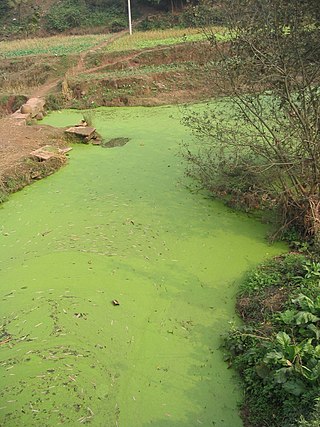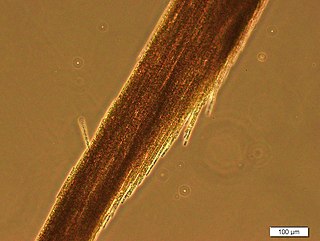
An algal bloom or algae bloom is a rapid increase or accumulation in the population of algae in fresh water or marine water systems. It is often recognized by the discoloration in the water from the algae's pigments. The term algae encompasses many types of aquatic photosynthetic organisms, both macroscopic multicellular organisms like seaweed and microscopic unicellular organisms like cyanobacteria. Algal bloom commonly refers to the rapid growth of microscopic unicellular algae, not macroscopic algae. An example of a macroscopic algal bloom is a kelp forest.

Eutrophication is a general term describing a process in which nutrients accumulate in a body of water, resulting in an increased growth of organism that may deplete the oxygen in the water. Eutrophication may occur naturally or as a result of human actions. Manmade, or cultural, eutrophication occurs when sewage, industrial wastewater, fertilizer runoff, and other nutrient sources are released into the environment. Such nutrient pollution usually causes algal blooms and bacterial growth, resulting in the depletion of dissolved oxygen in water and causing substantial environmental degradation.

Lake Okeechobee is the largest freshwater lake in the U.S. state of Florida. It is the eighth-largest natural freshwater lake among the 50 states of the United States and the second-largest natural freshwater lake contained entirely within the contiguous 48 states, after Lake Michigan.

Microcystins—or cyanoginosins—are a class of toxins produced by certain cyanobacteria, commonly known as blue-green algae. Over 250 different microcystins have been discovered so far, of which microcystin-LR is the most common. Chemically they are cyclic heptapeptides produced through nonribosomal peptide synthases.

Dead zones are hypoxic (low-oxygen) areas in the world's oceans and large lakes. Hypoxia occurs when dissolved oxygen (DO) concentration falls to or below 2 ml of O2/liter. When a body of water experiences hypoxic conditions, aquatic flora and fauna begin to change behavior in order to reach sections of water with higher oxygen levels. Once DO declines below 0.5 ml O2/liter in a body of water, mass mortality occurs. With such a low concentration of DO, these bodies of water fail to support the aquatic life living there. Historically, many of these sites were naturally occurring. However, in the 1970s, oceanographers began noting increased instances and expanses of dead zones. These occur near inhabited coastlines, where aquatic life is most concentrated.

Cyanotoxins are toxins produced by cyanobacteria. Cyanobacteria are found almost everywhere, but particularly in lakes and in the ocean where, under high concentration of phosphorus conditions, they reproduce exponentially to form blooms. Blooming cyanobacteria can produce cyanotoxins in such concentrations that they can poison and even kill animals and humans. Cyanotoxins can also accumulate in other animals such as fish and shellfish, and cause poisonings such as shellfish poisoning.

Aphanizomenon flos-aquae is a diverse group of cyanobacteria with both toxic and non-toxic strains found in brackish and freshwater environments globally, including the Baltic Sea and the Great Lakes. Recent genome sequencing efforts have identified 18 distinct varieties of Aphanizomenon flos-aquae, revealing its genetic complexity.

Lake Needwood is a 75-acre (300,000 m2) reservoir in Derwood, Maryland, United States. Located east of Rockville, in the eastern part of Montgomery County, it is situated on Rock Creek. The lake was created by damming Rock Creek in 1965 with the goal of providing flood control and reducing soil erosion. Lake Needwood also protects the water quality of the creek by functioning as a retention basin to trap sediment from storm-water runoff.

Lagoa das Sete Cidades is a twin lake situated in the crater of a dormant volcano on the Portuguese archipelago of the Azores. It consists of two small, ecologically different lakes connected by a narrow strait, which is crossed by a bridge. The volcano is located on the western third of the island of São Miguel. The Lagoa das Sete Cidades part of a natural landscape of communitarian interest: it is the largest body of water in the region and one of the most important freshwater resources in the archipelago.
Monomictic lakes are holomictic lakes that mix from top to bottom during one mixing period each year. Monomictic lakes may be subdivided into cold and warm types.

The Trophic State Index (TSI) is a classification system designed to rate water bodies based on the amount of biological productivity they sustain. Although the term "trophic index" is commonly applied to lakes, any surface water body may be indexed.

A harmful algal bloom (HAB), or excessive algae growth, is an algal bloom that causes negative impacts to other organisms by production of natural algae-produced toxins, water deoxygenation, mechanical damage to other organisms, or by other means. HABs are sometimes defined as only those algal blooms that produce toxins, and sometimes as any algal bloom that can result in severely lower oxygen levels in natural waters, killing organisms in marine or fresh waters. Blooms can last from a few days to many months. After the bloom dies, the microbes that decompose the dead algae use up more of the oxygen, generating a "dead zone" which can cause fish die-offs. When these zones cover a large area for an extended period of time, neither fish nor plants are able to survive. Harmful algal blooms in marine environments are often called "red tides".
An Olszewski tube is a pipe designed to bring oxygen-poor water from the bottom of a lake to the top. This tube was first proposed by a Polish limnologist named Przemysław Olszewski in 1961 and helps combat the negative effects of eutrophication, high nutrient content, in lakes. The basic concept behind the Olszewski tube is the reduction of nutrient concentration and destratification; the more specific goal is hypolimnetic withdrawal.

Nutrient pollution, a form of water pollution, refers to contamination by excessive inputs of nutrients. It is a primary cause of eutrophication of surface waters, in which excess nutrients, usually nitrogen or phosphorus, stimulate algal growth. Sources of nutrient pollution include surface runoff from farm fields and pastures, discharges from septic tanks and feedlots, and emissions from combustion. Raw sewage is a large contributor to cultural eutrophication since sewage is high in nutrients. Releasing raw sewage into a large water body is referred to as sewage dumping, and still occurs all over the world. Excess reactive nitrogen compounds in the environment are associated with many large-scale environmental concerns. These include eutrophication of surface waters, harmful algal blooms, hypoxia, acid rain, nitrogen saturation in forests, and climate change.
Seston refers to the particles suspended in bodies of water, such as oceans, lakes, and rivers. Small particles of seston may be formed by the breaking down of larger particles amidst the crashing of waves, mixing of water currents, or slow disintegration. The organic constituents of seston include plankton and detritus from decomposing organisms; the inorganic components of seston are of mineral origin, essentially particles of mud suspended in the water column.
Raphidiopsis raciborskii is a freshwater cyanobacterium.
Freshwater phytoplankton is the phytoplankton occurring in freshwater ecosystems. It can be distinguished between limnoplankton, heleoplankton, and potamoplankton. They differ in size as the environment around them changes. They are affected negatively by the change in salinity in the water.
The Namao is a ship ported in Gimli, Manitoba, Canada, whose purpose is to conduct research on Lake Winnipeg. It was originally built for the Canadian Coast Guard (CCG) but was eventually sold to the Lake Winnipeg Research Consortium (LWRC) who converted it to a Lake Winnipeg research vessel. Scientists using the Namao to research the environmental issues concerning the lake, for example the increasing eutrophication of the lake and the impact of invasive species. Using the Namao, the LWRC integrates education and community outreach into their work to promote sustainable living and development focussed on the youth in local communities surrounding Lake Winnipeg who are affected most by the changing dynamics of the lake.
Lake 226 is one lake in Canada's Experimental Lakes Area (ELA) in Ontario. The ELA is a freshwater and fisheries research facility that operated these experiments alongside Fisheries and Oceans Canada and Environment Canada. In 1968 this area in northwest Ontario was set aside for limnological research, aiming to study the watershed of the 58 small lakes in this area. The ELA projects began as a response to the claim that carbon was the limiting agent causing eutrophication of lakes rather than phosphorus, and that monitoring phosphorus in the water would be a waste of money. This claim was made by soap and detergent companies, as these products do not biodegrade and can cause buildup of phosphates in water supplies that lead to eutrophication. The theory that carbon was the limiting agent was quickly debunked by the ELA Lake 227 experiment that began in 1969, which found that carbon could be drawn from the atmosphere to remain proportional to the input of phosphorus in the water. Experimental Lake 226 was then created to test phosphorus' impact on eutrophication by itself.

Klamath Lake AFA, also called Klamath Lake Blue Green Algae and Klamath AFA, is a strain of Aphanizomenon flos-aquae. Small amounts of this cyanobacteria can be found in bodies of water worldwide, but it is notable for growing prolifically in Upper Klamath Lake, Oregon. Klamath AFA is a blue-green algae that has been harvested wild from Upper Klamath Lake since the 1980s and used as a dietary supplement.












